Authors: Xue, Youdi | Xia, Jihua | Ma, Chao | Dai, Weixiang | Zhang, Zhaochuan
Article Type:
Research Article
Abstract:
BACKGROUND: Osteoporosis is the most common disease in postmenopausal women and the elderly, which can lead to vertebral compression fracture. OBJECTIVE: To investigate the related factors of severe osteoporotic vertebral compression fracture (SOVCF) and evaluate the long-term outcomes of percutaneous kyphoplasty (PKP) for treating SOVCF through comparison with mild OVCF (MOVCF). METHODS: From September 2015 to March 2019, 294 osteoporotic vertebral compression fracture (OVCF) patients treated with PKP were analyzed. Compression of the anterior margin of the fractured vertebral body beyond 2/3 of the original height was defined as SOVCF. Baseline data, clinical
…and imaging findings before and after surgery and at the last follow-up were recorded. Numerical Rating Scale (NRS) was used to evaluate low back pain, the Oswestry Disability Index (ODI) was used to evaluate activity of daily life. Anterior vertebral height (AVH) and local kyphosis angle (LKA) was used to evaluate radiographic outcomes. During the follow-up, patients with recurrent back pain were examined by MRI to identify new fractures and the incidence of adjacent vertebral fracture (AVF) was recorded. Age, sex, body mass index (BMI), dual energy X-ray absorptiometry based T value, duration of symptom, history of trauma, steroid use, and fracture site were collected for univariate logistic regression analysis Variables with a P -value of less than 0.05 were then included in multivariate analysis to determine the related factors for SOVCF. RESULTS: Logistic regression analysis indicated that longer duration of symptom (OR = 1.109, 95%CI: 1.038–1.185, P = 0.002), lower T value (OR = 0.332, 95%CI: 0.139–0.763, P = 0.001), and steroid use (OR = 31.294, 95%CI: 1.020–960.449, P = 0.049) were related factors of SOVCF. Compared with the MOVCF group, the SOVCF group had longer operation time (57.3 ± 13.51 minutes vs 44.9 ± 8.13 minutes, P < 0.001), more radiation exposure (39.9 ± 7.98 times vs 25.5 ± 4.01 times, P < 0.001), and higher cement leakage rate (55.81% vs 18.73%, P < 0.001). At the last follow-up, the SOVCF group had higher NRS (2.28 ± 0.85 vs 1.30 ± 0.71, P < 0.001), and ODI (16.23 ± 4.43 vs 12.88 ± 3.34, P < 0.001). After operation and at the last follow-up, the SOVCF group had higher LKA and lower AVH (all P < 0.05). The AVF rate at the last follow-up was higher in the SOVCF group at the last follow-up (4.78% vs 18.60%, P < 0.001). CONCLUSION: Lower T value, longer duration of disease, and steroid use were related factors of SOVCF. Compared with MOVCF, PKP for SOVCF had longer operation time, more radiation exposure, and higher cement leakage rate, and the long-term outcomes were worsen.
Show more
Keywords: Kyphoplasty, bone mineral density, bone cement
DOI: 10.3233/BMR-230324
Citation: Journal of Back and Musculoskeletal Rehabilitation,
vol. Pre-press, no. Pre-press, pp. 1-10, 2024
Price: EUR 27.50




